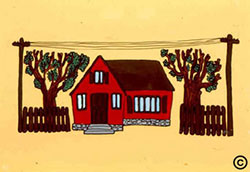Many established residential neighborhoods feature mature trees that are grotesquely pruned so they won’t interfere with overhead electrical lines. Modern varieties available at local nurseries make better choices around utility lines as they grow to a shorter mature height and do not threaten the continuous operation of overhead lines.
 Utility companies recommend that trees planted directly under, and up to 20 feet away, from electrical lines be limited to a 20-foot mature height. Attractive deciduous trees and shrubs which mature at 20 feet or less include Tatarian maple, Amur maple, serviceberry, Japanese tree lilac, Pekin tree lilac, North Star cherry, dwarf or semi-dwarf fruit trees, Pagoda dogwood, Princess Kay plum, hoptree, Russian hawthorn and thornless cockspur hawthorn.
Utility companies recommend that trees planted directly under, and up to 20 feet away, from electrical lines be limited to a 20-foot mature height. Attractive deciduous trees and shrubs which mature at 20 feet or less include Tatarian maple, Amur maple, serviceberry, Japanese tree lilac, Pekin tree lilac, North Star cherry, dwarf or semi-dwarf fruit trees, Pagoda dogwood, Princess Kay plum, hoptree, Russian hawthorn and thornless cockspur hawthorn.
Smaller evergreen trees include pinyon pine, bristlecone pine, Fat Albert blue spruce, and upright junipers such as Hillspire, Wichita Blue and Hetzi Columnaris. Many dwarf conifers are available from nurseries and garden centers.
Newer residential developments often have utility lines underground. In this case, digging holes and preparing soil for tree planting can result in damage to underground electric, telephone, gas, cable TV, sewer or water lines. Severing underground electric lines can be life-threatening. Contact the Utility Notification Center of Colorado at 1-800-992-1987 prior to landscaping or excavating. They will help you locate and identify underground utility lines.
For more information, see the following Planttalk Colorado™ video(s).
For more information, see the following Colorado State University Extension fact sheet(s).



